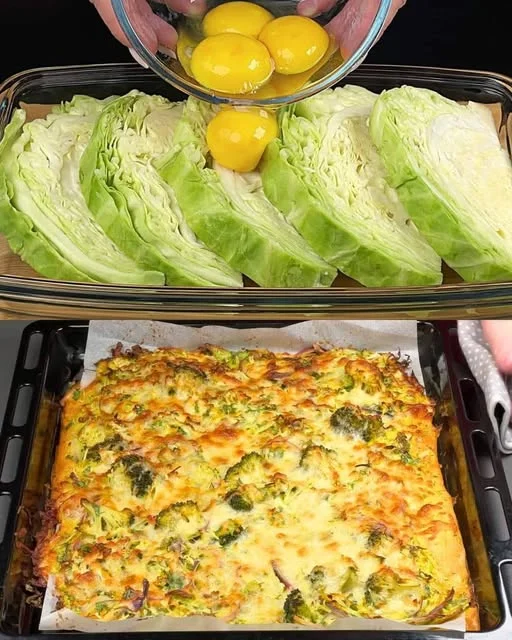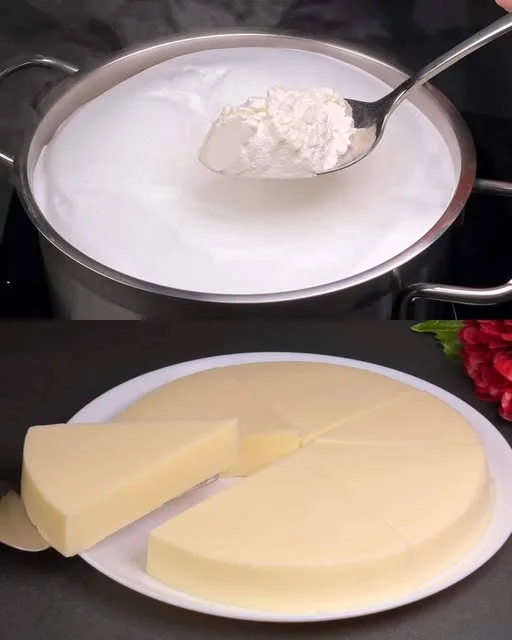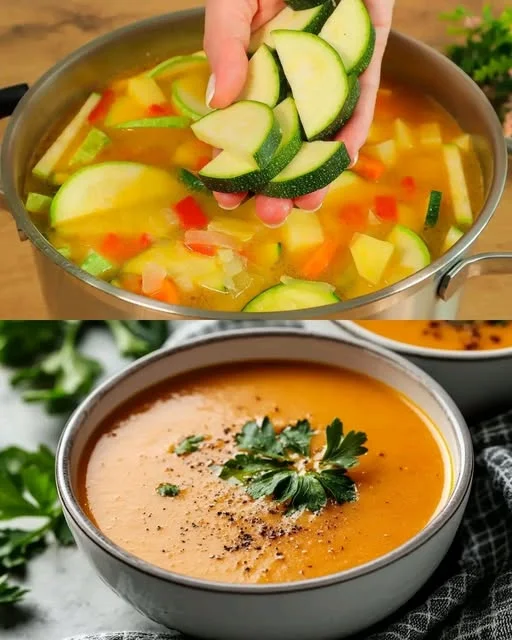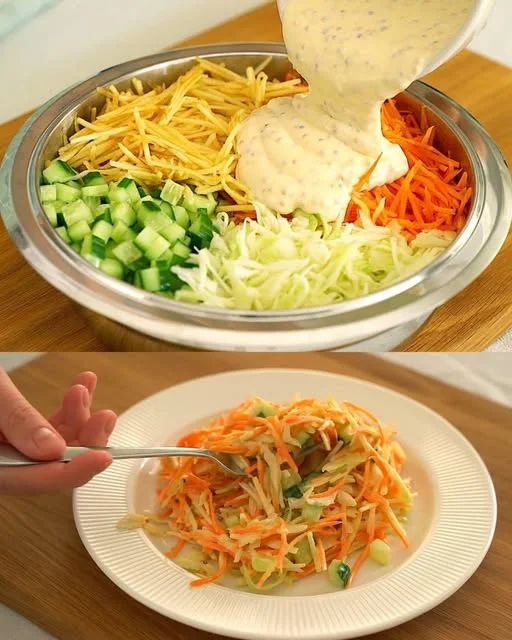I still remember the first time I made this soup — it was a cold, gray afternoon deep in October, when the wind pressed leaves against the windows like nature’s own mosaic. My hands were cold from running errands in the chill, and I craved something simple, warm, and grounding. My pantry was humble that day: a few potatoes, some mushrooms begging to be used, half a bag of noodles, and just enough broth to make something out of nothing.
As I began to cook, something unexpected happened. The aroma of garlic and mushrooms filled the kitchen with a quiet magic. The bubbling pot felt like it was telling stories of woodland walks, rainy afternoons, and moments of silence that somehow speak the loudest. What emerged from that pot wasn’t just soup — it was comfort in a ladle. Since then, this mushroom noodle soup has become more than a recipe. It’s a ritual.
If you’re looking for a way to warm both body and spirit, this bowl delivers in full.
A Flavorful Embrace in Every Spoonful
There’s a reason why this recipe resonates with so many. Mushroom noodle soup hits that rare culinary intersection where rustic charm meets nourishing satisfaction. The mushrooms bring an earthy depth, potatoes add creaminess, noodles offer softness and substance, and herbs like basil and garlic infuse aroma and warmth.
Unlike richer, cream-based mushroom soups, this one leans toward a lighter broth — making it equally suitable for lunch or dinner. Yet, don’t mistake it for bland. The layers of texture and taste create a satisfying experience, especially when the broth has simmered long enough to allow the vegetables to release their sweetness and the mushrooms to deepen the flavor.
Ingredients
| Ingredient | Amount |
|---|---|
| Onion | 1, chopped |
| Carrot | 1, chopped |
| Garlic | 3 cloves, minced |
| Mushrooms | 100 g, sliced |
| Potatoes | 2, peeled and diced |
| Corn (fresh or canned) | 100 g, drained |
| Salt | To taste |
| Black pepper | To taste |
| Basil | To taste |
| Vegetable broth | 1 liter |
| Noodles | 50 g |
Directions to a Steaming Bowl
- Sauté the Base: In a large pot over medium heat, add a splash of oil. Sauté the chopped onion, carrot, and garlic until softened and fragrant—about 5 minutes.
- Build the Flavor: Add the sliced mushrooms and cook for another 3–4 minutes until they release their juices.
- Hearty Additions: Stir in the diced potatoes and corn. Cook for 2 more minutes to blend the flavors.
- Pour and Simmer: Add the vegetable broth and bring everything to a boil. Reduce heat, cover, and simmer for 15 minutes, or until potatoes are just tender.
- Noodle Time: Add the noodles and cook according to package instructions (usually 7–10 minutes), or until they are soft but not mushy.
- Season to Finish: Stir in salt, black pepper, and basil to taste. Adjust the seasoning as desired.
- Serve Hot: Ladle into bowls and serve warm. Garnish with fresh herbs or a drizzle of olive oil if desired.
Nutrient Profile per Serving (approx. 4 servings)
| Nutrient | Amount (per serving) |
|---|---|
| Calories | 180–200 kcal |
| Protein | 5–6 g |
| Carbohydrates | 30–35 g |
| Fats | 4–5 g |
| Fiber | 4–5 g |
| Sodium | Depends on broth |
| Vitamin A | High (from carrots) |
| Iron | Moderate |
| Potassium | Good source |
Why This Soup Stands Out
1. Plant-Based and Nutrient-Rich
This soup is fully vegetarian, even vegan when made with egg-free noodles. It features whole vegetables, is low in fat, and provides a good mix of fiber, vitamins, and minerals. The mushrooms contribute B vitamins and antioxidants, while potatoes add potassium and slow-digesting carbs. Corn gives a hint of sweetness, and garlic is a well-known immune booster.
2. Flexible and Forgiving
Whether you’re working with what’s left in the fridge or planning a weeknight dinner, this soup adapts to you. Out of carrots? Add celery or parsnips. No noodles? Toss in rice, quinoa, or even barley. It’s the kind of recipe that forgives substitutions — and often benefits from them.
3. Minimal Equipment, Maximum Reward
All you need is one sturdy pot and a spoon to stir. This simplicity makes it ideal for small kitchens, student apartments, or anyone looking to cook without a mountain of cleanup afterward.
The Secret Ingredient: Memory
Soup is one of those dishes that transcends ingredients. It’s not just about nourishment — it’s about nostalgia. Maybe it reminds you of your grandmother’s kitchen, or of snow days spent bundled under blankets with a steaming bowl in your lap. This mushroom noodle soup has that kind of memory-making quality.
Its scent alone — earthy mushrooms mingled with onion and garlic — can transport you to a cabin in the woods or a quiet rainy Sunday. It invites slowness. You’ll find that people linger a little longer at the table when this is served.
Frequently Asked Questions
Can I use dried mushrooms instead of fresh?
Absolutely. Dried mushrooms have a concentrated flavor that can even enhance the richness of the broth. If using them, soak in warm water for about 20 minutes first. Don’t discard the soaking liquid — strain it and add it to your broth for an extra layer of umami.
Is this soup freezer-friendly?
Yes, but with a note: noodles can become a bit soft after freezing. If you plan to freeze it, consider cooking the noodles separately and adding them fresh when reheating. The vegetables and broth freeze beautifully and can be stored for up to 3 months.
What type of noodles work best?
You can use just about any variety — egg noodles, fusilli, rice noodles, or even broken spaghetti. Short noodles tend to hold up better and make for easier scooping. Whole grain options also work well if you’re looking to boost fiber.
Can I make this in a slow cooker?
Yes. Simply sauté the onions, garlic, and mushrooms beforehand to bring out their flavor, then transfer everything except the noodles to a slow cooker. Cook on low for 6–8 hours or on high for 3–4 hours. Add the noodles in the last 30 minutes of cooking.
How can I make this heartier for a full meal?
This soup is satisfying as-is, but you can easily bulk it up by adding canned chickpeas, lentils, or cubed tofu. A slice of crusty bread or a grilled sandwich on the side also makes it feel more like a full meal.
Is this recipe gluten-free?
As written, it contains regular noodles, but you can swap them out for gluten-free pasta or rice. Always check your broth to ensure it’s gluten-free as well.
Tips to Elevate Your Soup Game
- Caramelize Your Mushrooms: Take the time to really sauté them until golden. It adds incredible depth.
- Herb it Up: A sprig of thyme or rosemary while simmering can bring a savory edge. Remove before serving.
- Finish with Brightness: A squeeze of lemon juice or a splash of apple cider vinegar at the end sharpens the flavor and balances the sweetness of the corn and carrots.
- Garnish Wisely: A sprinkle of chopped fresh parsley, cracked black pepper, or even a dusting of nutritional yeast can take it from simple to spectacular.
Ideal Moments for This Soup
- After a long walk on a crisp day
- When you’re feeling under the weather and want something gentle
- As a starter for a dinner party — served in small bowls with herbed croutons
- A quiet lunch break when the world feels a bit too loud
It’s a dish that soothes, anchors, and reminds us that food can be both functional and poetic.
A Final Note from the Kitchen
This mushroom noodle soup is more than just a recipe — it’s an invitation. An invitation to slow down, to savor, to warm your hands on a bowl and your heart with the memory it creates. It’s for the moments when you want simplicity without sacrifice, comfort without compromise.
In a world that’s always rushing forward, this soup gently suggests: stay a little longer, breathe a little deeper, and maybe go back for seconds.
Let it nourish you in ways beyond the physical — because sometimes, the best meals are the ones that feel like coming home.

Whispers from the Forest: A Bowl Full of Comfort
Ingredients
Method
- Heat a splash of oil in a large pot over medium heat. Add chopped onion, carrot, and minced garlic. Sauté for 5 minutes until softened and fragrant.
- Add the sliced mushrooms and cook for another 3–4 minutes until they release their juices.
- Stir in the diced potatoes and corn. Cook for an additional 2 minutes.
- Pour in the vegetable broth and bring the mixture to a boil.
- Reduce heat to low, cover, and let it simmer for 15 minutes or until the potatoes are tender.
- Add the noodles and cook according to package instructions (about 7–10 minutes), until soft but not mushy.
- Season with salt, black pepper, and basil to taste. Adjust seasoning as needed.
- Serve hot and enjoy a nourishing bowl of rustic comfort.
Notes
- You can swap the noodles for rice or orzo for variation.
- Add a handful of spinach at the end for extra greens.
- Feel free to use dried basil, but fresh basil adds more aroma.
- Leftovers keep well for 2–3 days in the refrigerator.
- For a creamier version, stir in a splash of plant-based cream or coconut milk at the end.









